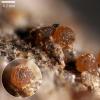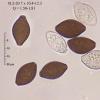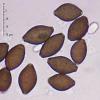
12-08-2015 21:57
Lepista ZacariasDear all,Can you help in identifying this ascomyce

15-08-2015 16:14
 Blasco Rafael
Blasco Rafael
Hola, he visto esta Sporormiella sobre excremento

14-08-2015 00:43
We have had a lot of dry weather lately and a log

14-08-2015 10:09
de pequeño tamañoNo se por donde comenzarJoseba

14-08-2015 01:00
Bonjour ! Je viens d'étudier Pulvinula carbonari

14-08-2015 10:13
estas pequeñas setas, a las que no he apreci

22-08-2014 18:01
 Bernard Declercq
Bernard Declercq
Hallo to everybody,Does anyone have following docu
These small (0.3-0.4 mm) orange perithecia grew on incubated rabitt dung for one month. They seem to be ostiolate because there is a crown of hyaline setae around the very inconspicuous, not protruding, neck. Perithecial walls are more o less glabrous. Asci clavate. Ascospores citriform, biporate with smooth walls.
According to GARCIA & al. (STUDIES IN MYCOLOGY 50: 63–68. 2004) the genus Sphaerodes currently comprise species characterized by non-ostiolate ascomata (if they are ostiolate they have a short neck surrounded by a crown of hyaline setae) and reticulate ascospores, umbonate at both ends. So only rest Melanospora as a good choice for my fungus. But I don't know a keyed species that matches with this collection.
Could you help me?
Thanks in advance

Good harvest! Your photos on the neck seems short and with this size can be spores can you look to M.fimbriata?
Michel.
Hi Michel
M. fimbriata is poorly described by Petch (Trans. Brit. Mycol. Soc.) with ELLIPSOID (sic) ascospores. And the somewhat platanoid, not really citriform ascospores drawn by Cannon & Hawksworth (pag. 126) together with the very small perithecia (40-50 microns in diam.) I think don't agree with my collection.
Thanks a lot



